
The Winter Months
STRASBOURG
THREATENED
| After January 6 German attacks in the Bitche
salient were contained. Gradually the pressure wore off and the enemy retired, discouraged
at what little success he had attained. Over on the right of the Seventh Army line
however, persistent armored attacks hacked away at the VI Corps positions north of
Haguenau. Early in January a large force of Germans had ferried the Rhine and seized a
small bridgehead ten miles north of Strasbourg at Gambsheim. Efforts to dislodge the enemy
proved futile, and, as the Germans poured into the small bridgehead, it developed
into a prime threat to the city of Strasbourg. An attack of the 12th Armored Division on
January 12-14 to destroy the Gambsheim pocket was thrown back with considerable loss. The
79th Division, on a front east and north of Haguenau, likewise was rapidly tiring under
the repeated strain of German attacks. To bolster and save this critical situation, the
36th was ordered from Montbronn. The 142nd, due to return to Montbronn from XXI Corps near
Saarbrucken. was waved on to Haguenau, an 80-mile total. The 141st remained in the line at
Montbronn attached to the 100th Division. |
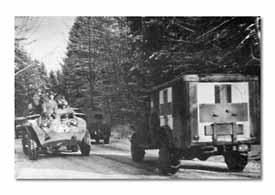
| When the call came vehicles and troops poured over the slick,
icy roads to meet the German challenge. (Below) General Patch, Seventh Army
Commander, stops to talk to a 141st detachment on way to the front. |
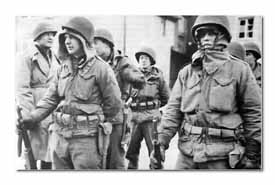
|
CIVILIANS
FEARFUL
A bleak, cold Haguenau greeted the 36th. Civilians
which a few weeks before had hailed liberation now gloomily considered evacuation and the
return of the hated Boche. Hospital and supply installations had departed or were moving
back, streets were deserted and an occasional incoming round of heavy artillery emphasized
the city’s danger.
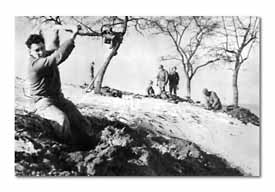
| For the first time in Divisional history a secondary or
"switch" line as constructed to back up the MLR. (Below) An AA gunner
at Montbronn scans the sky from his well-dug-in position. |
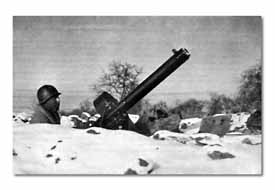
|
A few miles southeast of Haguenau the German
build-up in the Gambsheim-Herrlisheim pocket had reached alarming proportions. The 36th
was ordered to attack to wipe out the German bridgehead, but as the infantry moved up to
assembly positions on the morning of the 19th, the Corps Commander directed instead that
relief of the 12th Armored Division be effected immediately. The 143rd happened on to the stage just at the right moment,
for, during the afternoon, German armor broke out on the flat ground cast of Herrlisheim
and crossed the Zorn Canal, the main obstacle before Weyersheirn, with twenty tanks and
500 infantry. The presence of the 143rd element in Weyersheim and the arrival of other
Division reinforcements in the sector averted a clean breakthrough, and turned about and
rallied the 12th Armored elements falling back before the enemy assault. Very quickly a
line of defense along a small stream running southwest from Rohrwiller was selected. As
darkness closed in, 143rd troops moved to dig in and firmly establish it, knowing that the
Germans could be expected to follow-up with an even heavier attack.
|
WITHDRAWAL
ORDERED
| To the left of the new Division line enemy
pressure was accentuated by the loss of Drusenheim during darkness of the 19th where a
battalion of American infantry was cut off. The Rohrwiller-Weyersheim line was stabilized
and strengthened on the 20th, but that evening a general VI Corps withdrawal to the Moder
River north of Bichwiller pulled in the Division left, the 143rd abandoning Rohrwiller and
withdrawing behind a line of the 3rd Battalion, 142nd, at the forward edge of Bischwiller. Outposts of the 2nd Battalion, 143rd, holding the large
patch of woods east of Kurtzenhausen in the center of the Division line, reported contact
with groups of German infantry before midnight of the 20th. By morning close-in fighting
had developed and the Germans had seized the small patch of woods to the rear of the
bigger one. At noon waves of enemy tanks, 20 in all, with more infantry approached from
Herrlisheim. 636th TD gunners took careful aim from the woods and from Weyersheim, knocked
out six of them. 133rd Artillery Battalion destroyed at least one other. In the fighting
that lasted throughout the afternoon, Lt. Col. Marion P. Bowden led his 2nd Battalion in a
counterattack that killed 83 of the enemy and captured 176--some of the best of German
troops, the 10th SS Panzer Division. Acknowledging their Colonel’s part in the
battle, men of the 143rd have since called the scene of action "Bowden’s
Woods."
|
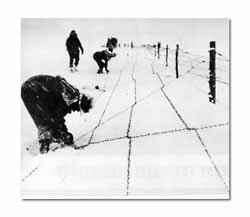
| In winter's coldest weather the engineers constructed
barbed-wire barriers for secondary defense. |
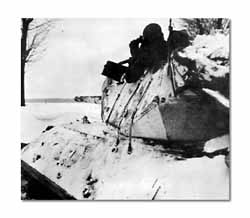
| In deep snow drifts tank destroyers waited for the enemy Panzer
onslaughts from Gambsheim pocket. |
|
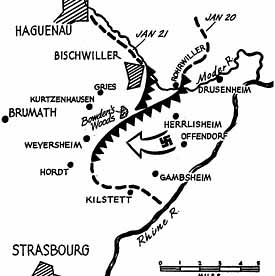 |
RUSSIANS MOVE
After this turning point the enemy made few other
probings of the Bischwiller-Weyersheim line. Quiet came over the sector as the defense was
daily improved. Snow fell to a heavy 12-inch covering. Novel searchlight defense was
introduced—artificial moonlight illuminating on the darkest nights any slight
movement to the front. In a week sweeping Russian gains on the Eastern Front forced the
Germans to withhold further offensive operations in Alsace. Noticeably, enemy initiative
died out and movement of troops away from the Gambsheim pocket was spotted. By the end of
the month there was very little action anywhere along the line. The Germans had been
prevented from making any inroads on the territory taken over and held by the 36th. Now
they would feel the sting of another full-scale T-Patch attack.
|
|







